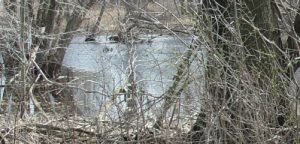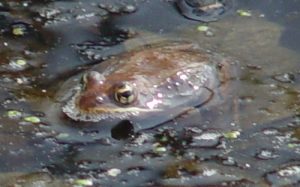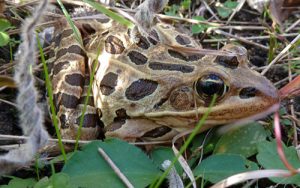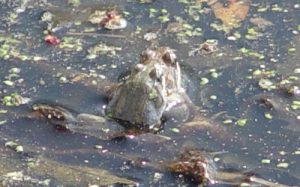Singin’ About Survival
 I can never decide which I like more in the spring, the dawn chorus of songbirds or the twilight symphony of frogs. We’ve been hearing the trill of American toads these last few days and the spring peepers, eastern chorus frogs and wood frogs are still going strong. And as beautiful as they sound to my ears, they must sound even sweeter to the tympanum (that’s frog-speak for “ears”) of the females.
I can never decide which I like more in the spring, the dawn chorus of songbirds or the twilight symphony of frogs. We’ve been hearing the trill of American toads these last few days and the spring peepers, eastern chorus frogs and wood frogs are still going strong. And as beautiful as they sound to my ears, they must sound even sweeter to the tympanum (that’s frog-speak for “ears”) of the females.
 And as much as I love frog calls, the thing that really amazes me is how these little guys even survive, especially through the winter. They’ve got no insulative fur or feathers, no bony scales or plates, and no sharp claws or teeth to speak of (though they do have little nubbins of teeth on their upper jaws and the roof of their mouths for grasping prey). Their skin is so thin and permeable that oxygen from the water can pass right through it… and so can the bug spray or sunscreen on your hands. If you like these little guys like I do, make sure to have clean hands if you’re going to touch them. Even better, dip those clean hands of yours in the lake or pond first to get them nice and moist and only then reach out to touch one of our smooth, slippery amphibians.
And as much as I love frog calls, the thing that really amazes me is how these little guys even survive, especially through the winter. They’ve got no insulative fur or feathers, no bony scales or plates, and no sharp claws or teeth to speak of (though they do have little nubbins of teeth on their upper jaws and the roof of their mouths for grasping prey). Their skin is so thin and permeable that oxygen from the water can pass right through it… and so can the bug spray or sunscreen on your hands. If you like these little guys like I do, make sure to have clean hands if you’re going to touch them. Even better, dip those clean hands of yours in the lake or pond first to get them nice and moist and only then reach out to touch one of our smooth, slippery amphibians.
But back to survival. How do these unassuming creatures do it? Let’s look at the mask-wearing, duck-quacking wood frog. When winter comes a’ knockin’ this frog buries itself beneath the leaf litter and soil of the forest floor… and freezes. Literally. Its heart ceases to pump. Its brain ceases to think. And a good portion of the fluids in its body freeze solid. But it doesn’t all freeze. Wood frogs have special proteins in their blood that cause it to freeze first. While this is happening, sugars flood their cells like gooey antifreeze so that the cells themselves stay un-frozen and relatively undamaged. Most of the freezing happens in the fluids between the cells. Wood frogs can survive several freeze-thaw cycles during the winter and, come spring, they thaw completely and literally return to life.
 However, don’t go making a frog-cicle out of just any frog you find! Our wood frogs, spring peepers and eastern chorus frogs – all of our early-season, small-bodied guys – can survive some degree of freezing. Our summer singers, the bigger bull frogs and green frogs, make it through the cold season at the bottom of a pond or lake. Their metabolism slows way down and they absorb enough oxygen to survive right from the water through that “thin skin” of theirs. But it’s not a true hibernation. Even in the winter (and even underwater) they still move around a bit. If you go to the Indian Springs Metropark Environmental Discovery Center, you might even see frog tracks on the pond dome in late winter. But enough science for the day. Open your window this evening, and if you live near a park, pond, ditch, swamp or vernal pool, see if you can hear the spring frog symphony, courtesy of some amazing amphibians!
However, don’t go making a frog-cicle out of just any frog you find! Our wood frogs, spring peepers and eastern chorus frogs – all of our early-season, small-bodied guys – can survive some degree of freezing. Our summer singers, the bigger bull frogs and green frogs, make it through the cold season at the bottom of a pond or lake. Their metabolism slows way down and they absorb enough oxygen to survive right from the water through that “thin skin” of theirs. But it’s not a true hibernation. Even in the winter (and even underwater) they still move around a bit. If you go to the Indian Springs Metropark Environmental Discovery Center, you might even see frog tracks on the pond dome in late winter. But enough science for the day. Open your window this evening, and if you live near a park, pond, ditch, swamp or vernal pool, see if you can hear the spring frog symphony, courtesy of some amazing amphibians!
Written by Justin Smith, Community Outreach Interpreter (Southern District)

